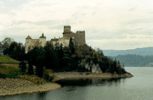| Studia Geologica Polonica |  |
 |
Geology of the Pieniny Klippen Belt and the Tatra Mts, Carpathians
Edited by K. Birkenmajer
Part XXI
Krzysztof Birkenmajer and Przemysław Gedl
Jurassic and Cretaceous strata in the Maruszyna IG-1 Deep Borehole (Pieniny Klippen Belt, Carpathians, Poland): lithostratigraphy, dinoflagellate cyst biostratigraphy, tectonics
Studia Geologica Polonica, 135: 7-54 | PDF - Full-text Article
Abstract
Krzysztof Birkenmajer1 and Przemysław
Gedl1
1 Institute of Geological Sciences, Cracow Research Centre, Polish Academy of Sciences, Poland;
ndbirken@cyf‑kr.edu.pl ; ndgedl@cyf‑kr.edu.pl
The paper presents core description of the Maruszyna IG-1 Deep Borehole located in the southernmost part of the Pieniny Klippen Belt of Poland, at the Kraków-Zakopane geotraverse of the Polish Carpathians. In the borehole, two Laramian nappes have been recognized: the Pieniny Nappe, PN (0 down to 930-960 m below the surface), and the Branisko Nappe, BN (1225-4843 m below the surface). The rocks of the Branisko Nappe are unconformably covered by the Maastrichtian marine molasse (conglomerates with large olistoliths derived from this nappe) - the Jarmuta Formation, JmF (930-1190 m below the surface). The Laramian overthrust zone: PN over JnF (and BN) lies at 930-960 m below the surface. The Branisko Nappe is subdivided into three first-order (major) and numerous, second-order (minor) tectonic scales. 29 samples from the Middle Jurassic, Lower and Upper Cretaceous rocks have been analyzed for palynofacies and organic-walled dinoflagellate cysts. Biostratigraphic interpretation of dinoflagellate cyst assemblages generally confirms the ages of the earlier-distinguished Jurassic and Cretaceous lithostratigraphic units in this borehole. An Aalenian dinoflagellate cyst assemblage from rocks attributed to the Harcygrund Shale Formation, suggests a slightly wider time-range of this unit than hitherto assumed: Aalenian-Lower Bajocian.
Key words: Jurassic, Cretaceous, Pieniny Klippen Belt, Polish Carpathians, deep borehole, lithostratigraphy, dinoflagellate cyst biostratigraphy, palynofacies, tectonics
1 Institute of Geological Sciences, Cracow Research Centre, Polish Academy of Sciences, Poland;
ndbirken@cyf‑kr.edu.pl ; ndgedl@cyf‑kr.edu.pl
The paper presents core description of the Maruszyna IG-1 Deep Borehole located in the southernmost part of the Pieniny Klippen Belt of Poland, at the Kraków-Zakopane geotraverse of the Polish Carpathians. In the borehole, two Laramian nappes have been recognized: the Pieniny Nappe, PN (0 down to 930-960 m below the surface), and the Branisko Nappe, BN (1225-4843 m below the surface). The rocks of the Branisko Nappe are unconformably covered by the Maastrichtian marine molasse (conglomerates with large olistoliths derived from this nappe) - the Jarmuta Formation, JmF (930-1190 m below the surface). The Laramian overthrust zone: PN over JnF (and BN) lies at 930-960 m below the surface. The Branisko Nappe is subdivided into three first-order (major) and numerous, second-order (minor) tectonic scales. 29 samples from the Middle Jurassic, Lower and Upper Cretaceous rocks have been analyzed for palynofacies and organic-walled dinoflagellate cysts. Biostratigraphic interpretation of dinoflagellate cyst assemblages generally confirms the ages of the earlier-distinguished Jurassic and Cretaceous lithostratigraphic units in this borehole. An Aalenian dinoflagellate cyst assemblage from rocks attributed to the Harcygrund Shale Formation, suggests a slightly wider time-range of this unit than hitherto assumed: Aalenian-Lower Bajocian.
Key words: Jurassic, Cretaceous, Pieniny Klippen Belt, Polish Carpathians, deep borehole, lithostratigraphy, dinoflagellate cyst biostratigraphy, palynofacies, tectonics
Krzysztof Birkenmajer
Geology of the Lower Subtatric Nappe, Kopy Sołtysie area, Eastern Tatra Mts (West Carpathians, Poland)
Studia Geologica Polonica, 135: 55-116 | PDF - Full-text Article
Abstract
Krzysztof Birkenmajer
Mailing address: Institute of Geological Sciences, Cracow Research Centre, Polish Academy of Sciences, Poland; ndbirken@cyf‑kr.edu.pl
Stratigraphic sequence of the Lower Subtatric Succession in the eastern part of the Polish Tatra Mountains includes 15 Triassic, Jurassic and Lower Cretaceous mappable lithostratigraphic units of formation ranks. Some formations include also non-mappable lithostratigraphic units of local significance, of member and bed ranks. This stratigraphic succession is typical of the Lower Subtatric Nappe (= Križna Nappe) which originated during the meso-Cretaceous (Turonian) Mediterranean orogenic phase. The older post-nappe cover (?Upper Cretaceous or ?Paleocene-Lower Eocene), unconformable upon the Lower Subtatric Nappe, is represented by an unfossiliferous Gosau-facies conglomerate (Rusinowa Fm.) consisting of Triassic to Lower Cretaceous rock fragments derived from this nappe. The Lower Subtatric Nappe has been subdivided into several second-order thrust-sheets (partial-nappes vel daughter units) of restricted lateral extension, thrust one over another from north to south (retro-arc). The Gosau-facies conglomerate (Rusinowa Fm.) takes part in the thrust-sheet architecture which was accomplished in the Tatra Mts prior to the Middle Eocene transgression, either during the Laramian (Cretaceous/Paleocene boundary) or the Pyrenean (Middle Eocene) orogenic phases. The younger post-nappe cover consists of the Middle Eocene basal conglomerates and nummulitic limestones succeeded by a thick Podhale Flysch complex (Oligo- cene). A dense transversal (vertical to strike-slip) fault system which dissects rocks of the Lower Subtatric Nappe, its daughter units and post-nappe covers, had formed due to meridional stress active during the Middle Miocene.This fault system plays an important part in correct recognition and correlation of particular tectonic units.
Key words: Tatra Mts, Carpathians, Lower Subtatric Nappe, Mesozoic, stratigraphy, tectonics
Mailing address: Institute of Geological Sciences, Cracow Research Centre, Polish Academy of Sciences, Poland; ndbirken@cyf‑kr.edu.pl
Stratigraphic sequence of the Lower Subtatric Succession in the eastern part of the Polish Tatra Mountains includes 15 Triassic, Jurassic and Lower Cretaceous mappable lithostratigraphic units of formation ranks. Some formations include also non-mappable lithostratigraphic units of local significance, of member and bed ranks. This stratigraphic succession is typical of the Lower Subtatric Nappe (= Križna Nappe) which originated during the meso-Cretaceous (Turonian) Mediterranean orogenic phase. The older post-nappe cover (?Upper Cretaceous or ?Paleocene-Lower Eocene), unconformable upon the Lower Subtatric Nappe, is represented by an unfossiliferous Gosau-facies conglomerate (Rusinowa Fm.) consisting of Triassic to Lower Cretaceous rock fragments derived from this nappe. The Lower Subtatric Nappe has been subdivided into several second-order thrust-sheets (partial-nappes vel daughter units) of restricted lateral extension, thrust one over another from north to south (retro-arc). The Gosau-facies conglomerate (Rusinowa Fm.) takes part in the thrust-sheet architecture which was accomplished in the Tatra Mts prior to the Middle Eocene transgression, either during the Laramian (Cretaceous/Paleocene boundary) or the Pyrenean (Middle Eocene) orogenic phases. The younger post-nappe cover consists of the Middle Eocene basal conglomerates and nummulitic limestones succeeded by a thick Podhale Flysch complex (Oligo- cene). A dense transversal (vertical to strike-slip) fault system which dissects rocks of the Lower Subtatric Nappe, its daughter units and post-nappe covers, had formed due to meridional stress active during the Middle Miocene.This fault system plays an important part in correct recognition and correlation of particular tectonic units.
Key words: Tatra Mts, Carpathians, Lower Subtatric Nappe, Mesozoic, stratigraphy, tectonics